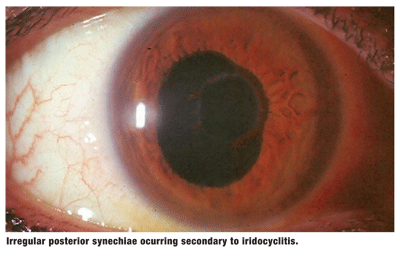 A 57-year-old woman is being treated for a protracted bilateral case of iridocyclitis. She has a history of chronic recurrent iridocyclitis in both eyes, though it occasionally recurs unilaterally. It seems to occur every other year.
A 57-year-old woman is being treated for a protracted bilateral case of iridocyclitis. She has a history of chronic recurrent iridocyclitis in both eyes, though it occasionally recurs unilaterally. It seems to occur every other year.
She has been using prednisolone acetate 1% q2h in each eye for the past 11 weeks. Best-corrected visual acuity is 20/30 O.U. with early cataract formation. Her external eye is white, and she has no discomfort. The anterior chamber reaction, initially assessed as grade 1, is now reduced to only rare cells and minimal flare in each eye. Her IOP is 21mm Hg O.D. and 22mm Hg O.S.
Due to cataract development from high doses of topical steroids and clinical improvement in inflammation, her prednisolone dosing is reduced to q.i.d.
At follow-up two weeks later, she complains of mild orbital discomfort and decreased quality of vision. Her visual acuity has not changed, but she says that her vision is smoky. The anterior chamber cellular response also appears unchanged, though perhaps there is a small increase in flare present. Her IOP has risen to 45mm Hg O.D. and 47mm Hg O.S.
The etiology of the IOP elevation in this case could be due to either steroid-induced glaucoma or poor control of iridocyclitis. This brings us to this months topic: the management of glaucoma occurring in chronic iridocyclitis.

Etiology
In younger patients, secondary glaucoma associated with acute anterior uveitis usually develops as a result of severe anterior chamber inflammation.
Older patients, however, are more likely to develop secondary glaucoma, not from acute anterior uveitis, but from chronic iridocyclitis, which involves lesser amounts of inflammation.1
Typically, elevated IOP occurs more commonly in chronic intraocular inflammation than in acute anterior uveitis. One study found that IOP elevation occurred from uveitis in 19% of patients overall; 12% of these were of acute cases, but 26% were chronic cases.2 Likewise, another study noted increased IOP overall in 42% of eyes with uveitis, with IOP elevation present in only 26% of eyes with acute anterior uveitis, but in 46% in eyes with chronic uveitis.1
Biomicroscopically, there will be a modest number of inflammatory cells and a greater degree of flare in chronic iridocyclitis. In patients with excessive flare and development of open-angle glaucoma, trabecular meshwork outflow can be impeded both by the accumulation of inflammatory cells and outflow incapacity of proteinaceous aqueous humor.3-7 Flare may be more responsible than the amount of inflammatory cells for the development of IOP elevation.7
Occasionally, a case of chronic iridocyclitis will develop peripheral anterior synechiae, resulting in closed angle glaucoma. In older patients, minimal amounts of inflammation may overcome a trabecular meshwork with declining function.8
Managing Inflammation and Intraocular Pressure
Corticosteroids are the mainstay of treatment for chronic iridocyclitisbut, they may also contribute to an increase in IOP. While a clinically significant steroid-induced rise in IOP may take several weeks to develop, the response time may be shorter in cases of chronic iridocyclitis in which abnormalities in the trabecular meshwork and alteration of aqueous humor composition and dynamics are already occurring.
The increased prevalence of glaucoma in chronic iridocyclitis reflects the cumulative effects of inflammation and steroid use.
The clinical conundrum involves late IOP rises in patients on long-term steroid therapy. How can one discern if the rise in IOP is due to steroid use or uncontrolled inflammation?
If the IOP rises concomitantly with a reduction in steroids, then suspect poor control of the inflammation. In such cases, patients will often say that the quality of their vision has deteriorated. They may mention that their vision is smoky or hazy, though Snellen acuity remains unchanged. Biomicroscopically, there may be no change in the anterior chamber reactionsave for an increase in flare, which causes patients to look through more protein in their aqueous. When this happens, an increase in steroid dosage often results in a reduction of IOP, though glaucoma medications may also be required.
Under-treatment of inflammation in chronic iridocyclitis for fear of steroid-induced IOP elevation is false economynot to mention potentially dangerous. Aggressive control of inflammation is mandatory for these patients.
Aqueous suppressants are most effective for managing iridocyclitis-related IOP rise. But, the efficacy of glaucoma medications may be variable and unpredictable in these cases. Topical beta-blockers are an option, though they may have little effect in cases of inflammatory glaucoma.8 Conversely, topical carbonic anhydrase inhibitors have been found to work especially well in lowering IOP in inflammatory glaucoma.8,9 An alpha-2 adrenergic agonist is also an acceptable option. Or, consider oral carbonic anhydrase inhibitors. Avoid miotics, as they increase vascular permeability and can worsen inflammation in anterior uveitis.10 Likewise, avoid prostaglandin analogs whenever possible, because they may exacerbate inflammation.11
Trabeculectomy is a viable surgical option for patients with medically uncontrolled glaucoma occurring from chronic iridocyclitis.12 Performed without adjunctive antimetabolites, however, trabeculectomy has a high failure rate due to fibrosis and scarring of the sclerostomy site.12,13
Mitomycin C is frequently used intraoperatively to reduce fibrous proliferation and diminish scarring, which greatly increases the surgical success rate of the procedure.13-17 Glaucoma drainage devices, such as the Ahmed valve and Baerveldt implant, may be necessary, especially in cases of previous trabeculectomy failure.18-21
As for our patient, topical steroids were increased to hourly while awake. After five days, the quality of her vision improved, and her IOP dropped to 24mm Hg O.D. and 27mm Hg O.S. So, steroid dosing was changed to q2h and a topical carbonic anhydrase inhibitor was added to better assist in IOP control.
When embarking on long-term steroid treatment of patients with chronic iridocyclitis, be aware that glaucoma can occur at any time, either from uncontrolled inflammation, prolonged steroid use or a combination of both. It is important to know when to either increase or decrease steroids and what topical or surgical options exist for these patients.
1. Herbert HM, Viswanathan A, Jackson H, et al. Risk factors for elevated intraocular pressure in uveitis. J Glaucoma 2004 Apr;13(2):96-9.
2. Panek WC, Holland GN, Lee DA, et al. Glaucoma in patients with uveitis. Br J Ophthalmol 1990 Apr;74(4):223-7.
3. Souissi K, El Afrit MA, Trojet S, et al. Etiopathogeny of intraocular pressure modifications in uveitis. J Fr Ophtalmol 2006 Apr;29(4):456-61.
4. Moorthy RS, Mermoud A, Baerveldt G, et al. Glaucoma associated with uveitis. Surv Ophthalmol 1997 Mar-Apr;41(5):361-94.
5. Mermoud A. Physiopathology of uveitic glaucoma. Klin Monatsbl Augenheilkd. 1997 May;210(5):269-73.
6. Dietlein TS. Glaucoma and uveitis. Causes of and treatment options for increased intraocular pressure in cases of inflammatory ophthalmology. Ophthalmologe 2003 Nov;100(11):991-1006.
7. Ladas JG, Yu F, Loo R, et al. Relationship between aqueous humor protein level and outflow facility in patients with uveitis. Invest Ophthalmol Vis Sci 2001 Oct;42(11):2584-8.
8. Kok H, Barton K. Uveitic glaucoma. Ophthalmol Clin North Am 2002 Sep;15(3):375-87.
9. Sung VC, Barton K. Management of inflammatory glaucomas. Curr Opin Ophthalmol 2004 Apr;15(2):136-40.
10. Mori M, Araie M, Sakurai M, et al. Effects of pilocarpine and tropicamide on blood-aqueous barrier permeability in man. Invest Ophthalmol Vis Sci 1992 Feb; 33(2):416-23.
11. Sacca S, Pascotto A, Siniscalchi C, et al. Ocular complications of latanoprost in uveitic glaucoma: three case reports. J Ocul Pharmacol Ther 2001 Apr;17(2):107-13.
12. Souissi K, El Afrit MA, Trojet S, et al. Trabeculectomy for the management of uveitic glaucoma. J Fr Ophtalmol 2006 Feb;29(2):153-6.
13. Mietz H, Raschka B, Krieglstein GK. Risk factors for failures of trabeculectomies performed without antimetabolites. Br J Ophthalmol 1999 Jul;83(7):814-21.
14. Novak-Laus K, Mandic Z, Ivekovic R, et al. Trabeculectomy with mitomycin C in glaucoma associated with uveitis. Coll Antropol 2005;29 Suppl 1:17-20.
15. Prata JA Jr, Neves RA, Minckler DS, et al. Trabeculectomy with mitomycin C in glaucoma associated with uveitis. Ophthalmic Surg 1994 Sep-Oct;25(9):616-20.
16. Yalvac IS, Sungur G, Turhan E, et al. Trabeculectomy with mitomycin-C in uveitic glaucoma associated with Behcet disease. J Glaucoma 2004 Dec;13(6):450-3.
17. Ceballos EM, Beck AD, Lynn MJ. Trabeculectomy with antiproliferative agents in uveitic glaucoma. J Glaucoma 2002 Jun;11(3):189-96
18. Da Mata A, Burk SE, Netland PA, et al. Management of uveitic glaucoma with Ahmed glaucoma valve implantation. Ophthalmology 1999 Nov;106(11):2168-72.
19. Ceballos EM, Parrish RK 2nd, Schiffman JC. Outcome of Baerveldt glaucoma drainage implants for the treatment of uveitic glaucoma. Ophthalmology 2002 Dec;109(12):2256-60.
20. Gil-Carrasco F, Salinas-VanOrman E, Recillas-Gispert C, et al. Ahmed valve implant for uncontrolled uveitic glaucoma. Ocul Immunol Inflamm 1998 Mar;6(1):27-37.
21. Ozdal PC, Vianna RN, Deschenes J. Ahmed valve implantation in glaucoma secondary to chronic uveitis. Eye 2006 Feb;20(2):178-83.

